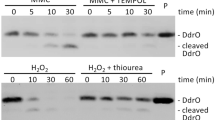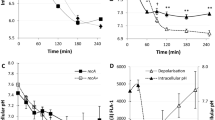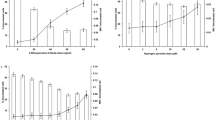Abstract
THE role of endogenous sulphydryl compounds (SH) as partial determinants of radio-resistance has been challenged in wild type and in radio-sensitive mutants of Micrococcus radiodurans and in cell-free radio-protective extracts prepared from the wild strain1,2. While agents such as p-hydroxymercuribenzoate (HMB) and iodoacetic acid (IAA) complex cellular sulphydryl groups and sensitize this cell to ionizing radiation3,4, it has been shown that both HMB and IAA suffer radiolytic decomposition and possibly poison the cell by a non-sulphydryl vector5,6. When HMB was used to titrate the endogenous SH of eleven bacterial strains, however, a linear relationship was discovered between the quantity bound and both the LD90 and D0 exposures7. Recent studies reveal (a) that M. radiodurans binds more HMB than expected from its larger mass, (b) that the change in HMB binding after both X-irradiation and heat exposure is similar, and (c) that this response differs from responses of more radio-sensitive bacteria such as Escherichia coli B/r and Sarcina lutea.
This is a preview of subscription content, access via your institution
Access options
Subscribe to this journal
Receive 51 print issues and online access
$199.00 per year
only $3.90 per issue
Buy this article
- Purchase on Springer Link
- Instant access to full article PDF
Prices may be subject to local taxes which are calculated during checkout
Similar content being viewed by others
References
Moseley, B. E. B., J. Gen. Microbiol, 49, 293 (1967).
Serianni, R. W., and Bruce, A. K., Nature, 218, 485 (1968).
Bruce, A. K., and Malchman, W. H., Radiat. Res., 24, 473 (1965).
Lee, J. S., Anderson, A. W., and Elliker, P. R., Radiat. Res., 19, 593 (1963).
Mahoney, G., Thomas, C. C., and Bruce, A. K., Radiat. Res., 35, 552 (1968).
Shenoy, M. A., Singh, B. B., and Gopal-Ayengar, A. R., Science, 160, 999 (1968).
Bruce, A. K., Sansone, P. A., and MacVittie, T. J., Radiat. Res., 38, 95 (1969).
Dose, K., Physical Processes in Radiation Biology, 253 (1963).
Alexander, P., and Hamilton, L. D. G., Arch. Biochem. Biophys., 88, 128 (1960).
Hamm, R., and Hofmann, K., Nature, 207, 1269 (1965).
Dean, C. J., Feldschreiber, P., and Lett, J. T., Nature, 209, 49 (1966).
Lett, J. T., Feldschreiber, P., Little, J. G., Steele, K., and Dean, C. J., Proc. Roy. Soc., B, 176, 184 (1967).
Author information
Authors and Affiliations
Rights and permissions
About this article
Cite this article
FREEDMAN, M., FREEDMAN, P. & BRUCE, A. Distinctive Sulphydryl Responses in X-Irradiated and in Heat-treated Micrococcus radiodurans. Nature 224, 183–184 (1969). https://doi.org/10.1038/224183a0
Received:
Issue Date:
DOI: https://doi.org/10.1038/224183a0
Comments
By submitting a comment you agree to abide by our Terms and Community Guidelines. If you find something abusive or that does not comply with our terms or guidelines please flag it as inappropriate.



